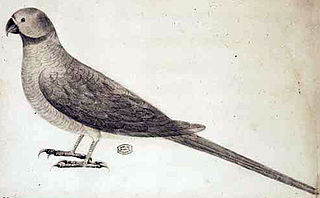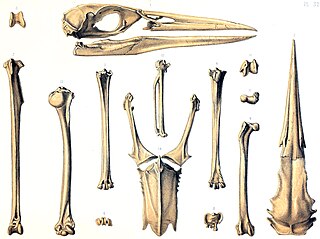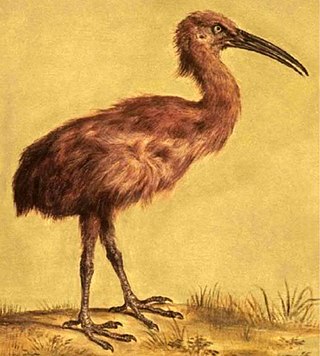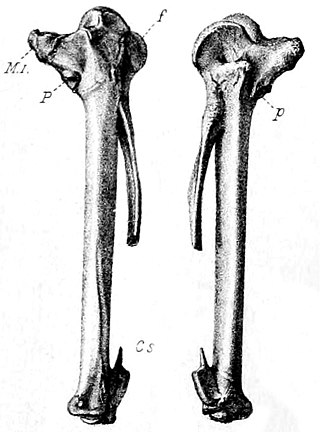
The true owls or typical owls are one of the two generally accepted families of owls, the other being the barn owls (Tytonidae). This large family comprises 230 living or recently extinct species in 24 genera. The typical owls have a cosmopolitan distribution and are found on every continent except Antarctica.

Newton's parakeet, also known as the Rodrigues parakeet or Rodrigues ring-necked parakeet, is an extinct species of parrot that was endemic to the Mascarene island of Rodrigues in the western Indian Ocean. Several of its features diverged from related species, indicating long-term isolation on Rodrigues and subsequent adaptation. The rose-ringed parakeet of the same genus is a close relative and probable ancestor. Newton's parakeet may itself have been ancestral to the endemic parakeets of nearby Mauritius and Réunion.

The Eurasian scops owl, also known as the European scops owl or just scops owl, is a small owl in the typical owl family Strigidae. Its breeding range extends from southern Europe eastwards to southern Siberia and the western Himalayas. It is migratory, wintering in Africa south of the Sahara.

Scops owls are typical owls in family Strigidae belonging to the genus Otus and are restricted to the Old World. Otus is the largest genus of owls with 59 species. Scops owls are colored in various brownish hues, sometimes with a lighter underside and/or face, which helps to camouflage them against the bark of trees. Some are polymorphic, occurring in a greyish- and a reddish-brown morph. They are small and agile, with both sexes being compact in size and shape. Female scops owls are usually larger than males.

The Japanese scops-owl is a small owl species in the family Strigidae, or true owl family. It is a member of the genus Otus, the scops owl genus. It is resident to Japan, China, Korea, and Russia.

The broad-billed parrot or raven parrot is a large extinct parrot in the family Psittaculidae. It was endemic to the Mascarene island of Mauritius. The species was first referred to as the "Indian raven" in Dutch ships' journals from 1598 onwards. Only a few brief contemporary descriptions and three depictions are known. It was first scientifically described from a subfossil mandible in 1866, but this was not linked to the old accounts until the rediscovery of a detailed 1601 sketch that matched both the subfossils and the accounts. It is unclear what other species it was most closely related to, but it has been classified as a member of the tribe Psittaculini, along with other Mascarene parrots. It had similarities with the Rodrigues parrot, and may have been closely related.

Strix is a genus of owls in the typical owl family (Strigidae), one of the two generally accepted living families of owls, with the other being the barn-owl (Tytonidae). Common names are earless owls or wood owls, though they are not the only owls without ear tufts, and "wood owl" is also used as a more generic name for forest-dwelling owls. Neotropical birds in the genus Ciccaba are sometimes included in Strix.

The Rodrigues night heron is an extinct species of heron that was endemic to the Mascarene island of Rodrigues in the Indian Ocean. The species was first mentioned as "bitterns" in two accounts from 1691–1693 and 1725–1726, and these were correlated with subfossil remains found and described in the latter part of the 19th century. The bones showed that the bird was a heron, first named Ardea megacephala in 1873, but moved to the night heron genus Nycticorax in 1879 after more remains were described. The specific name megacephala is Greek for "great-headed". Two related extinct species from the other Mascarene islands have also been identified from accounts and remains: the Mauritius night heron and the Réunion night heron.

The Rodrigues rail, also known as Leguat's gelinote or Leguat's rail, is an extinct species of the rail family that was endemic to the Mascarene island of Rodrigues. The bird was first documented from life by two accounts from 1691–93 and 1725–26. Subfossil remains were later discovered and correlated with the old accounts in 1874, and the species was named E. leguati in Leguat's honour. It is generally kept in its own genus, Erythromachus, but has sometimes been assigned to the genus Aphanapteryx along with its close relative the red rail of Mauritius; their relationship with other rails is unclear.

The red rail is an extinct species of rail that was endemic to the Mascarene island of Mauritius, east of Madagascar in the Indian Ocean. It had a close relative on Rodrigues island, the likewise extinct Rodrigues rail, with which it is sometimes considered congeneric, but their relationship with other rails is unclear. Rails often evolve flightlessness when adapting to isolated islands, free of mammalian predators, and that was also the case for this species. The red rail was a little larger than a chicken and had reddish, hairlike plumage, with dark legs and a long, curved beak. The wings were small, and its legs were slender for a bird of its size. It was similar to the Rodrigues rail, but was larger, and had proportionally shorter wings. It has been compared to a kiwi or a limpkin in appearance and behaviour.

The Mauritius sheldgoose, also known as the Mauritius shelduck, is an extinct species of sheldgoose that was endemic to the island of Mauritius. While geese were mentioned by visitors to Mauritius in the 17th century, few details were provided by these accounts. In 1893, a carpometacarpus wing-bone and a pelvis from the Mare aux Songes swamp were used to name a new species of comb duck, Sarcidiornis mauritianus. These bones were connected to the contemporary accounts of geese and later determined to belong to a species related to the Egyptian goose and placed in the sheldgoose genus Alopochen. The Mauritius and Réunion sheldgoose may have descended from Egyptian geese that colonised the Mascarene islands.

The Mascarene Teal, also known as Sauzier's Teal and Mauritian Duck, is an extinct dabbling duck that formerly occurred on the islands of Mauritius and Réunion.

The Rodrigues parrot or Leguat's parrot is an extinct species of parrot that was endemic to the Mascarene island of Rodrigues. The species is known from subfossil bones and from mentions in contemporary accounts. It is unclear to which other species it is most closely related, but it is classified as a member of the tribe Psittaculini, along with other Mascarene parrots. The Rodrigues parrot bore similarities to the broad-billed parrot of Mauritius, and may have been related. Two additional species have been assigned to its genus, based on descriptions of parrots from the other Mascarene islands, but their identities and validity have been debated.

The Rodrigues scops owl, also known as Rodrigues owl, Rodrigues lizard owl, Leguat's owl, or Rodrigues little owl, was a small owl. It lived on the Mascarene island of Rodrigues, but it is nowadays extinct. It is part of the three Mascarene owls, formerly classified in the genus Mascarenotus, although they are now classified in the genus Otus. Like many of the Mascarene land-birds, the genus was a distinct relative to South-East Asian taxa, in this case apparently being a descendant of the direct ancestor of the Oriental scops owl. This insular scops owl had evolved gigantism, becoming twice as large and four times heavier than its continental ancestor.
The Réunion scops owl, also known as the Réunion owl or Réunion lizard owl, was a small owl that occurred on the Mascarene island of Réunion, but became extinct before any living birds were described; it is only known from subfossil bones. One of the three Mascarene owls, it was formerly classified in the genus Mascarenotus, and most likely was similar to a long-eared owl in size and appearance, but with nearly naked legs. However, according to recent studies, it and its relatives belong to the genus Otus, and is likely descended from the Otus sunia lineage.

The Seychelles scops owl, also known as bare-legged scops owl or syer is a rare scops owl species, which only occurs in the Morne Seychellois National Park on the Seychelles island of Mahé.

The Mascarene owls, also known as Mascarene scops owls or lizard owls, are a group of owls formerly classified in their own genus Mascarenotus, but now thought to represent a polyphyletic grouping within the genus Otus. They were restricted to the Mascarene Islands in the Indian Ocean. All three species, the Réunion scops owl, Mauritius scops owl, and Rodrigues scops owl, are now extinct.

The São Tomé scops owl is a species of owl in the true owl family, Strigidae. It is endemic to São Tomé Island, part of São Tomé and Príncipe, in the Gulf of Guinea, off the western equatorial coast of Central Africa.

The Mascarene grey parakeet, Mauritius grey parrot, or Thirioux's grey parrot, is an extinct species of parrot which was endemic to the Mascarene Islands of Mauritius and Réunion in the western Indian Ocean. It has been classified as a member of the tribe Psittaculini, along with other parrots from the Islands.






















